ServletContext与ServletConfig
ServletContext
- 整个JavaWeb工程可以用一个对象表示,这个对象就是ServletContext
ServletConfig
- 我们在web.xml中给某一个Servler配置一些配置信息,当服务器被启动的时候,这些配置信息就会被封装到某一个ServletConfig对象中去,因此ServletConfig表示的某一个Servlrt的配置文件
首先在eclipse中创建一个默认的Servlet文件
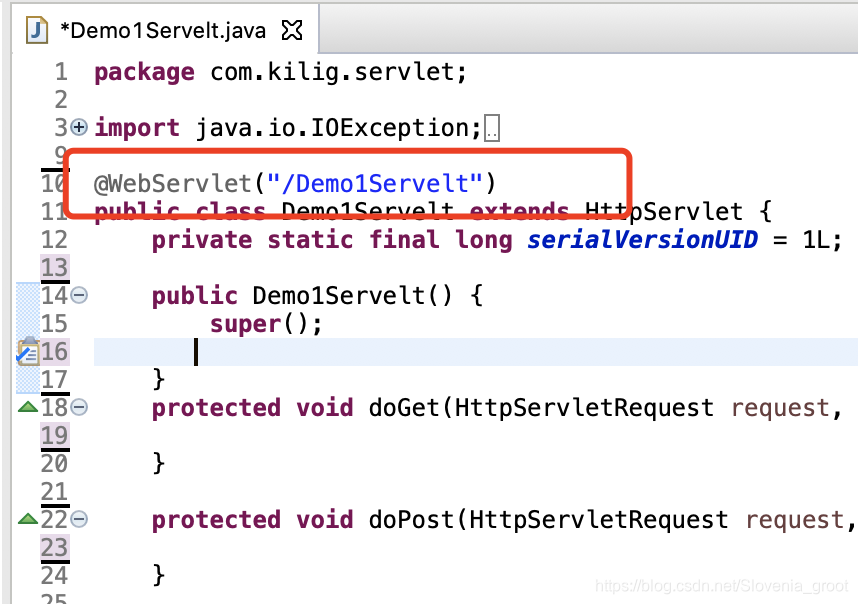
这个表示的就是Servlet对外访问的虚拟路径
package com.kilig.servlet;
import java.io.IOException;
import javax.servlet.ServletContext;
import javax.servlet.ServletException;
import javax.servlet.annotation.WebServlet;
import javax.servlet.http.HttpServlet;
import javax.servlet.http.HttpServletRequest;
import javax.servlet.http.HttpServletResponse;
@WebServlet("/Demo1Servelt")
public class Demo1Servelt extends HttpServlet {
protected void doGet(HttpServletRequest request, HttpServletResponse response)
throws ServletException, IOException {
// 获取代表某一个JavaWeb工程的ServletContext对象
// Context对象是一个域对象,可以往某一个域对象中存放数据,并且还可以取出存放的数据
ServletContext context =this.getServletContext();
// 在context中存放数据
context.setAttribute("username", "张三");
// 取出数据
Object result =context.getAttribute("username");
// 打印输出结果
System.out.println(result);
}
protected void doPost(HttpServletRequest request, HttpServletResponse response)
throws ServletException, IOException {
}
}
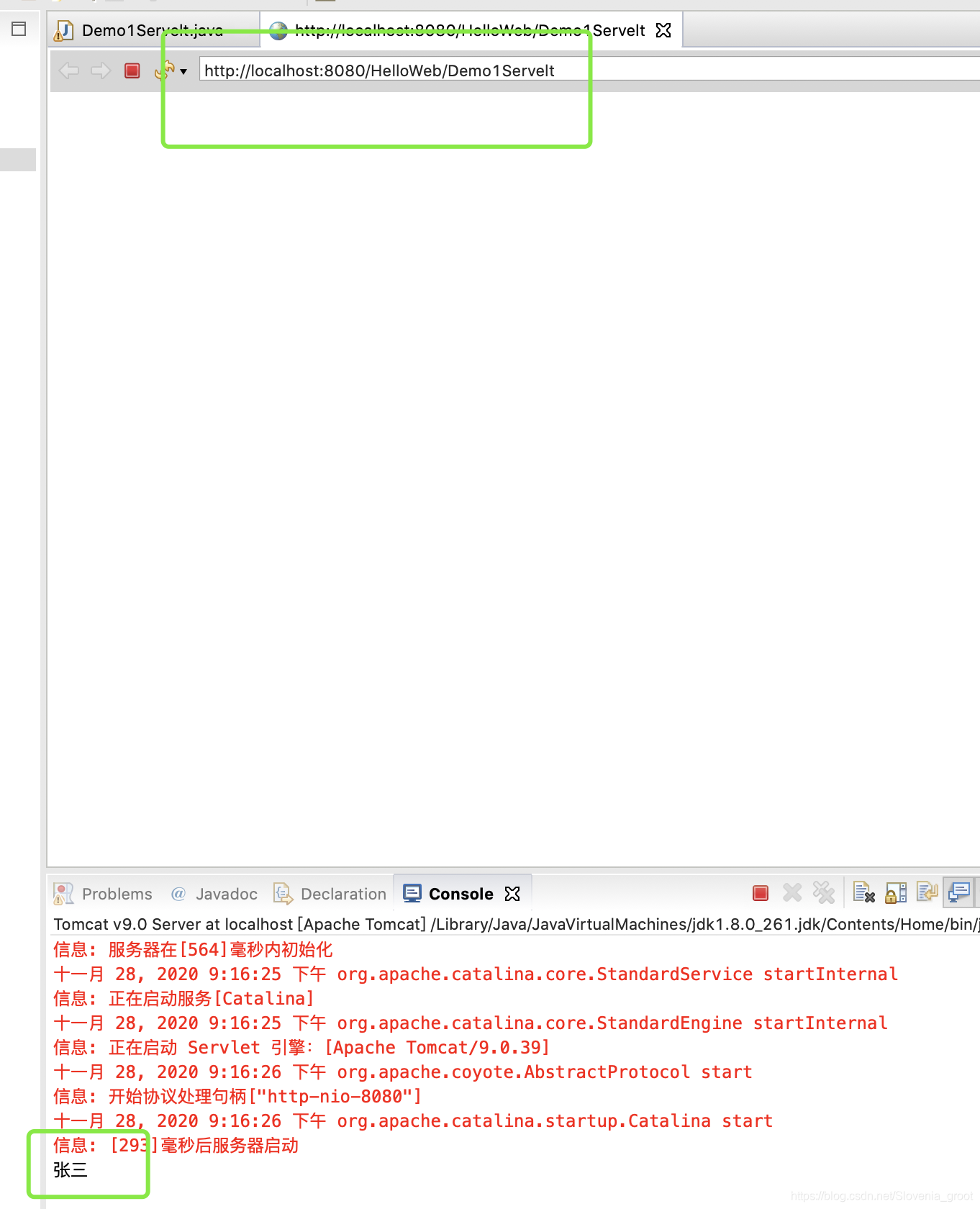
此外,在同一个工程目录下的其他Servlet的文件也可以获取Context中定义的数据
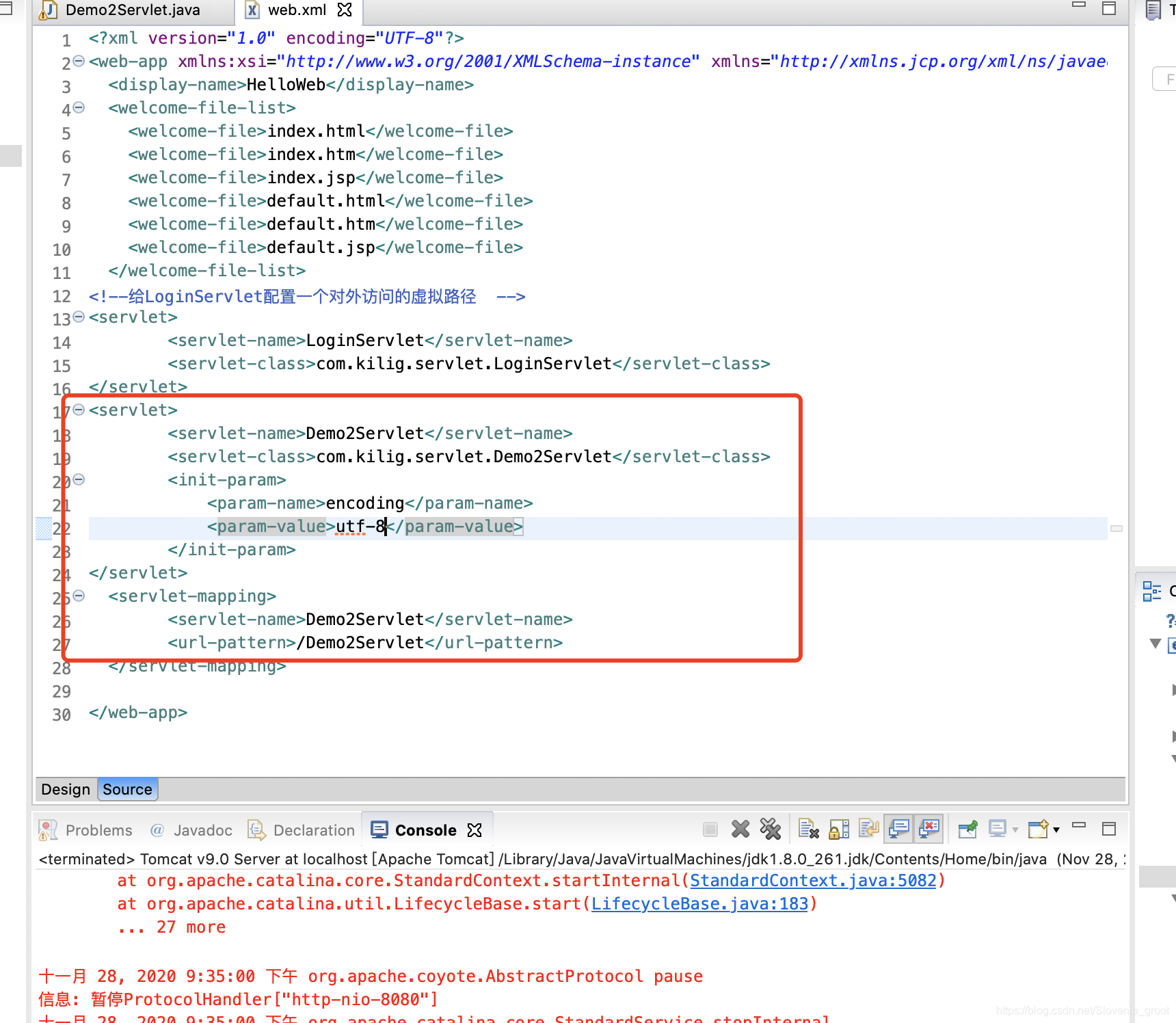
package com.kilig.servlet;
import java.io.IOException;
import javax.servlet.ServletConfig;
import javax.servlet.ServletContext;
import javax.servlet.ServletException;
import javax.servlet.annotation.WebServlet;
import javax.servlet.http.HttpServlet;
import javax.servlet.http.HttpServletRequest;
import javax.servlet.http.HttpServletResponse;
@WebServlet("/Demo2Servlet")
public class Demo2Servlet extends HttpServlet {
protected void doGet(HttpServletRequest request, HttpServletResponse response) throws ServletException, IOException {
// 获取ServletConfig对象
ServletConfig sc =this.getServletConfig();
// 获取sc对象中的参数信息
String encoding =sc.getInitParameter("encoding");
System.out.println(encoding);
}
protected void doPost(HttpServletRequest request, HttpServletResponse response) throws ServletException, IOException {
}
}
转发与重定向
- 实现转发调用的是HttpServletRequest对象中的方法,实现重定向调用的是HttpServletResponse对象中的方法
- 转发时浏览器的url地址栏不会发生改变,重定向时浏览器中的url地址会发生改变
- 转发时浏览器只请求一次服务器,重定向时浏览器请求两次服务器
首先创建一个index.jsp页面
<%@ page language="java" contentType="text/html; charset=UTF-8"
pageEncoding="UTF-8"%>
<!DOCTYPE html>
<html>
<head>
<meta charset="UTF-8">
<title>Insert title here</title>
</head>
<body>
<center>
<form action="" method="post">
<p>UserName:<input type="text" name="username"></p>
<p>Password:<input type="password" name="password"></p>
<p>
<input type="submit" value="Login">
<input type="reset" value="Reset">
</p>
</form>
</center>
</body>
</html>
成功界面success.jsp
<%@ page language="java" contentType="text/html; charset=UTF-8"
pageEncoding="UTF-8"%>
<!DOCTYPE html>
<html>
<head>
<meta charset="UTF-8">
<title>Success Page</title>
</head>
<body>
<h3 style="color:red">Success Page</h3>
</body>
</html>
失败界面fail.jsp
<%@ page language="java" contentType="text/html; charset=UTF-8"
pageEncoding="UTF-8"%>
<!DOCTYPE html>
<html>
<head>
<meta charset="UTF-8">
<title>Fail Page</title>
</head>
<body>
<h3 style="color:green">Fail Page</h3>
</body>
</html>
然后在JavaResous中新建一个LoginServlet类
package com.kilig.servlet;
import java.io.IOException;
import javax.servlet.ServletException;
import javax.servlet.annotation.WebServlet;
import javax.servlet.http.HttpServlet;
import javax.servlet.http.HttpServletRequest;
import javax.servlet.http.HttpServletResponse;
@WebServlet("/LoginServlet")
public class LoginServlet extends HttpServlet {
protected void doGet(HttpServletRequest request, HttpServletResponse response)
throws ServletException, IOException {
// 获取表单提交的数据
// getParameter()方法可以获取请求的参数信息
String usernameString= request.getParameter("username");
String passwordString= request.getParameter("password");
System.out.println("username is: "+usernameString);
System.out.println("password is: "+passwordString);
// 如果username=admin password=123 ,则跳转success.jsp否则跳转fail.jsp
// 1.通过转发实现跳转
if("admin".equals(usernameString) && "123".equals(passwordString))
request.getRequestDispatcher("/success.jsp").forward(request, response);
else
request.getRequestDispatcher("/fail.jsp").forward(request, response);
}
protected void doPost(HttpServletRequest request, HttpServletResponse response)
throws ServletException, IOException {
}
}
然后在配置一下web.xml。 编写路径
<?xml version="1.0" encoding="UTF-8"?>
<web-app xmlns:xsi="http://www.w3.org/2001/XMLSchema-instance" xmlns="http://xmlns.jcp.org/xml/ns/javaee" xsi:schemaLocation="http://xmlns.jcp.org/xml/ns/javaee http://xmlns.jcp.org/xml/ns/javaee/web-app_4_0.xsd" id="WebApp_ID" version="4.0">
<display-name>HelloWeb</display-name>
<welcome-file-list>
<welcome-file>index.html</welcome-file>
<welcome-file>index.htm</welcome-file>
<welcome-file>index.jsp</welcome-file>
<welcome-file>default.html</welcome-file>
<welcome-file>default.htm</welcome-file>
<welcome-file>default.jsp</welcome-file>
</welcome-file-list>
<!--给LoginServlet配置一个对外访问的虚拟路径 -->
<servlet>
<servlet-name>LoginServlet</servlet-name>
<servlet-class>com.kilig.servlet.LoginServlet</servlet-class>
</servlet>
<servlet-mapping>
<servlet-name>LoginServlet</servlet-name>
<url-pattern>/LoginServlet</url-pattern>
</servlet-mapping>
</web-app>
转发
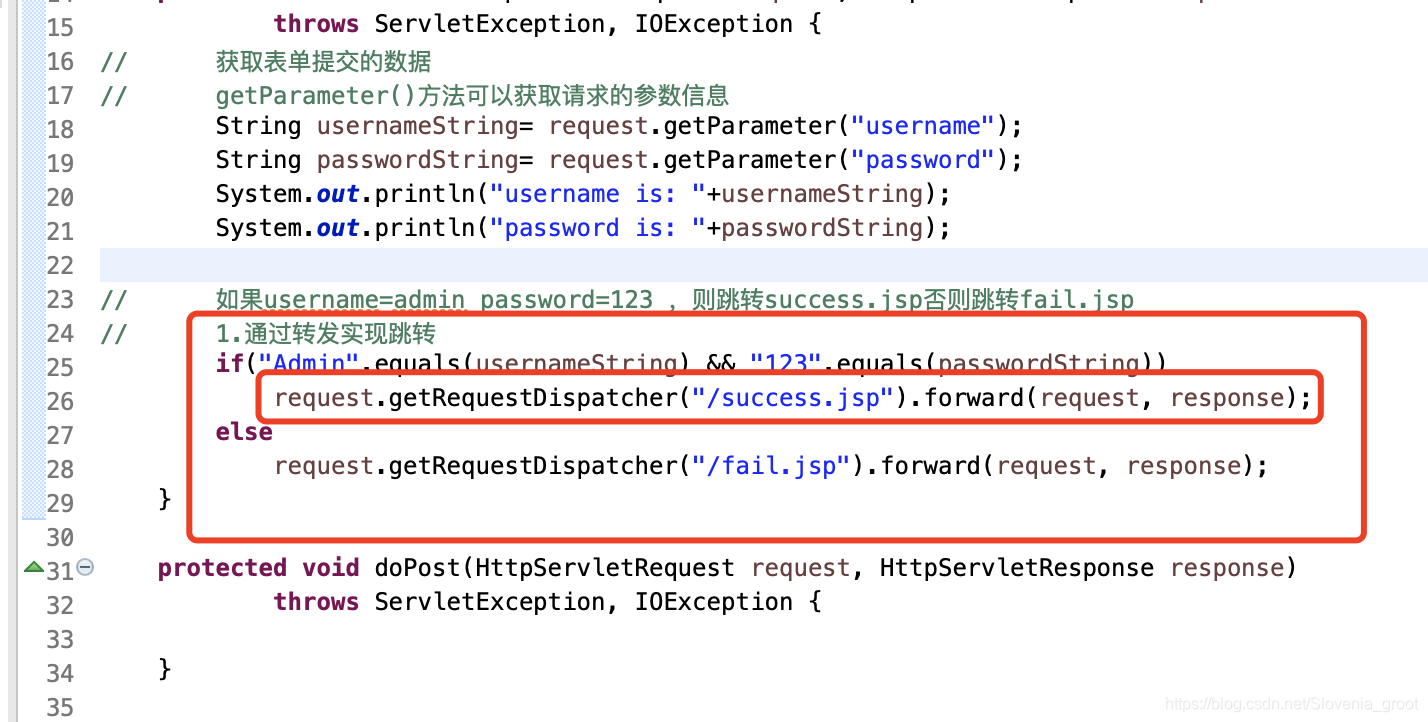
重定向(使用重定向需要完整的路径)
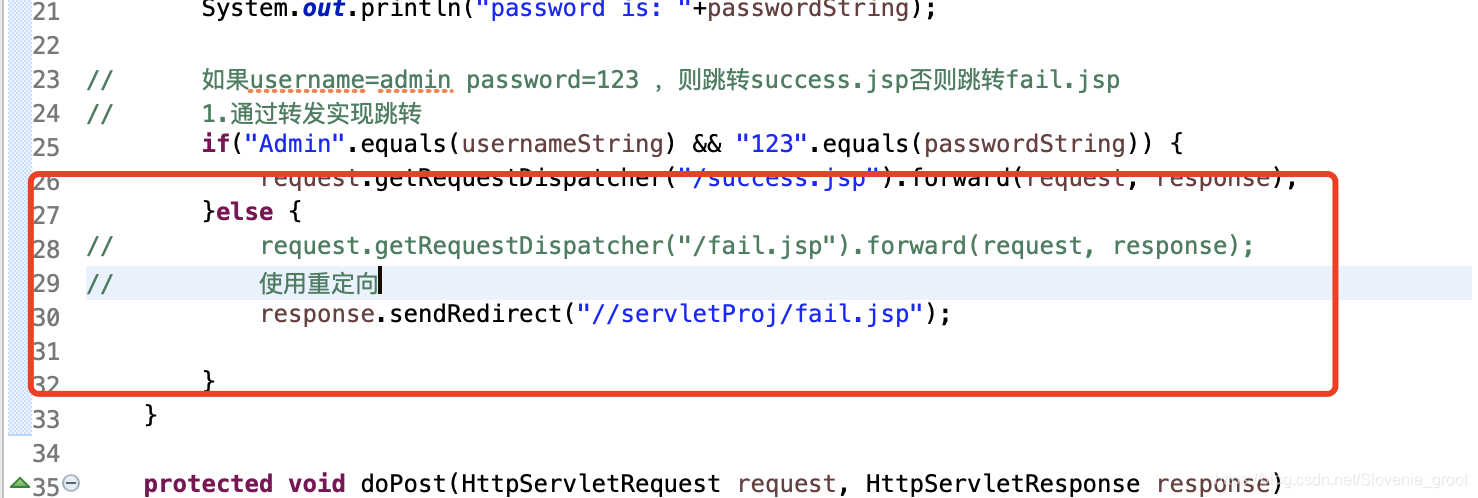








 本文介绍了JavaWeb开发中ServletContext和ServletConfig的概念及其使用,ServletContext代表整个JavaWeb工程,而ServletConfig包含了Servlet的配置信息。通过示例展示了如何在Servlet中存取ServletContext中的数据。此外,还详细解释了HTTP请求的转发和重定向的区别,并给出了登录验证的示例,演示了在登录成功或失败时如何通过转发和重定向来展示不同的页面。
本文介绍了JavaWeb开发中ServletContext和ServletConfig的概念及其使用,ServletContext代表整个JavaWeb工程,而ServletConfig包含了Servlet的配置信息。通过示例展示了如何在Servlet中存取ServletContext中的数据。此外,还详细解释了HTTP请求的转发和重定向的区别,并给出了登录验证的示例,演示了在登录成功或失败时如何通过转发和重定向来展示不同的页面。
















 229
229

 被折叠的 条评论
为什么被折叠?
被折叠的 条评论
为什么被折叠?








